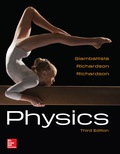
Concept explainers
(a)
The stopping potential of incident light.
(a)
Answer to Problem 74P
The stopping potential of incident light is
Explanation of Solution
Write the expression to find the maximum kinetic energy.
Here,
Write the expression for Einstein’s photoelectric equation.
Here,
Equate equations (I) and (II) to find the work function for sodium.
Re-arrange the expression to find the work function for sodium.
Substitute
Re-arrange the equation (III) to find the stopping potential.
Conclusion:
Substitute
(b)
The stopping potential for the incident light when the intensity is
(b)
Answer to Problem 74P
The stopping potential for the incident light when the intensity
Explanation of Solution
Write the equation to find the stopping potential.
The stopping potential of incident light is independent on intensity of light as in the above expression. Thus, the stopping potential of light cannot be changed when the intensity of the light is increased from
Conclusion:
The stopping potential of the incident light is
(c)
Work function if the sodium.
(c)
Answer to Problem 74P
Work function if the sodium is
Explanation of Solution
Write the expression to find the maximum kinetic energy.
Here,
Write the expression for Einstein’s photoelectric equation.
Here,
Equate equations (I) and (II) to find the work function for sodium.
Re-arrange the expression to find the work function for sodium.
Conclusion:
Substitute
Want to see more full solutions like this?
Chapter 27 Solutions
Physics
- 8. With the aid of a diagram draw the following electric circuit and use the resistor as the load, (a) Closed circuit (b) Open circuitarrow_forwardLab 8 Part 3 PHET Wave Interface simulation. I am having trouble with this part of the lab.arrow_forwardMick and Rick are twins born on Earth in the year 2175. Rick grows up to be an Earth-bound robotics technician while Mick becomes an intergalactic astronaut. Mick leaves the Earth on his first space mission in the year 2200 and travels, according to his clock, for 10 years at a speed of 0.75c. Unfortunately, at this point in his journey, the structure of his ship undergoes mechanical breakdown and the ship explodes. How old is Rick when his brother dies?arrow_forward
 College PhysicsPhysicsISBN:9781305952300Author:Raymond A. Serway, Chris VuillePublisher:Cengage Learning
College PhysicsPhysicsISBN:9781305952300Author:Raymond A. Serway, Chris VuillePublisher:Cengage Learning University Physics (14th Edition)PhysicsISBN:9780133969290Author:Hugh D. Young, Roger A. FreedmanPublisher:PEARSON
University Physics (14th Edition)PhysicsISBN:9780133969290Author:Hugh D. Young, Roger A. FreedmanPublisher:PEARSON Introduction To Quantum MechanicsPhysicsISBN:9781107189638Author:Griffiths, David J., Schroeter, Darrell F.Publisher:Cambridge University Press
Introduction To Quantum MechanicsPhysicsISBN:9781107189638Author:Griffiths, David J., Schroeter, Darrell F.Publisher:Cambridge University Press Physics for Scientists and EngineersPhysicsISBN:9781337553278Author:Raymond A. Serway, John W. JewettPublisher:Cengage Learning
Physics for Scientists and EngineersPhysicsISBN:9781337553278Author:Raymond A. Serway, John W. JewettPublisher:Cengage Learning Lecture- Tutorials for Introductory AstronomyPhysicsISBN:9780321820464Author:Edward E. Prather, Tim P. Slater, Jeff P. Adams, Gina BrissendenPublisher:Addison-Wesley
Lecture- Tutorials for Introductory AstronomyPhysicsISBN:9780321820464Author:Edward E. Prather, Tim P. Slater, Jeff P. Adams, Gina BrissendenPublisher:Addison-Wesley College Physics: A Strategic Approach (4th Editio...PhysicsISBN:9780134609034Author:Randall D. Knight (Professor Emeritus), Brian Jones, Stuart FieldPublisher:PEARSON
College Physics: A Strategic Approach (4th Editio...PhysicsISBN:9780134609034Author:Randall D. Knight (Professor Emeritus), Brian Jones, Stuart FieldPublisher:PEARSON





